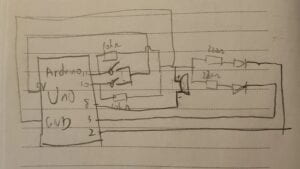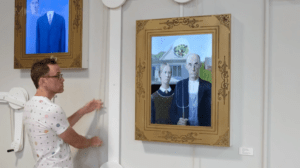Recitation 2 Documentation
In the course of this recitation class, I built the circuit in Step 1&2 according to the blueprint and cooperated with Siwei Chen to finish Step 3. Here is my documentation of the three circuits.
Circuit 1 and 2 are quite straightforward and easy to build. I finished the circuit and typed the code into Arduino by myself quickly. Circuit 1, basically, is to keep making LED gradually turn on and then fade off. Circuit 2 is to let the buzzer sound like the melody of Never Gonna Give You Up.
But Circuit 3 is a bit tricky to me. The first challenge that I encountered is that the website showing the circuit failed to show the resistance of the resistors. My solution is to use the Resistance Calculator on the internet and figured out the exact resistance of the resistors shown on the website. The second challenge I met with is the complex circuit containing many resistors, LEDs and wires. I have failed to connect the circuit for many times, but finally I succeeded and played the game with my partner.
(Below is my own drawing of circuit 3)

Questions
- In my idea, a microphone can be used as a substitution for the buttons. When two players are playing the game, the one who finishes singing the melody of Never Gonna Give You Up more accurately wins the game. This can make the game more interactive because it transferred the digital input into an analog one. To be more specific, pushing the button has only two states of input, but detecting the frequency of human voices have many.
- The 10kOhm resistors help keep the current flowing through the buzzer weak, so that when buttons are pressed, the current flowing through the buzzer can get stronger and let the buzzer make sounds.
- In Chapter 2 Getting Started with Arduino, the author mainly discussed about reusing and modifying existing technology. I found the World Famous Painting Re-creation Interactive Device as a good example of the projects shown in the book. “Shake the handle, press the pump, pull the rope, and the world famous painting close interaction, works for the Pittsburgh Children’s Museum. It is applicable to exhibitions, cultural tours, real estate, parent-child activities. Neil Mendoza teaches art and Technology at Stanford University and UCLA. His work has been exhibited at Ars Electronica, Barbican Centre and V & a galleries, partners include Adobe, Adidas, IBM, Bingley, Audi and other well-known brands.”(机械名画交互装置 – MANA Global new media art platform Arts/Design/Science & Technology/Cross-field innovation (manamana.net))This project is based on existing world famous paintings and adds interactivity to it. I think it involves a lot of tinkering, which is a key term described in the chapter. And also, it involves co-operation between many corporations and institutions, which also epitomized what the chapter proposes.

